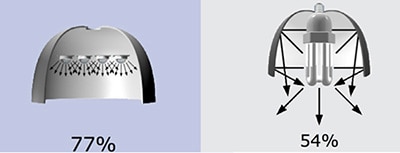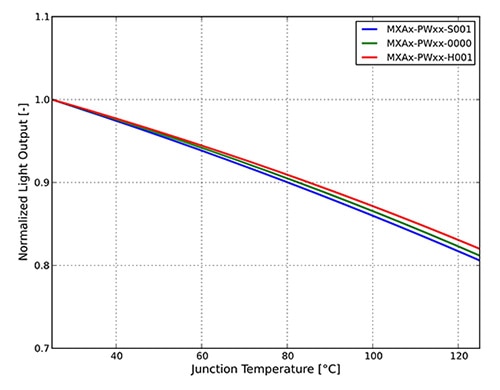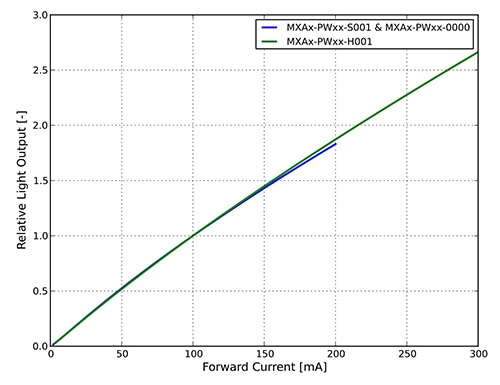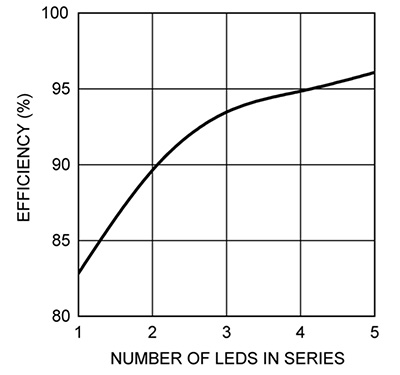Lighting Design for Optimum Luminosity
投稿人:DigiKey 北美编辑
2016-04-27
A lighting designer could be forgiven for thinking that selecting the number of LEDs for a luminaire is simple, but that’s not the case. While manufacturers provide accurate luminosity data for their devices at a given junction temperature and forward voltage/current, the actual output in any given application can be influenced by many other factors.
By understanding these factors, the designer can make a considered choice at each stage of the design process to ensure every LED used in the product delivers the best trade-off between luminosity, efficacy, lifetime and cost. Careful design will optimize the number of LEDs required for a given specification, reducing the complexity, size and cost of the product. This article takes the reader through the main steps of the design process and describes the effect of each on the performance of the end product.
Meeting the benchmark
LED lighting products fall into two camps: A retrofit, where the designer is challenged with bringing the benefit of LEDs to existing form factors such as the popular MR16 (see the TechZone article "LEDs Address Drawbacks of Halogen MR16 Fixtures"), and those where the designer is given a free hand to come up with a complete luminaire, such as a light engine plus fixture. This second option generally results in better electrical, optical and thermal performance than a retrofit because the designer is not constrained by the limitations of the existing fixture’s form factor. This article focuses on this option.
In the majority of instances, the luminaire is designed to replace existing lighting or target a standard application. Each case provides the designer with a benchmark for the new product’s electrical and optical performance which in turn makes it much easier to set the luminosity, efficacy (defined in this article as luminous flux (lm)/electrical power (W)), and lifetime and cost design goals. Once these goals are fixed, the designer can narrow down his choice (and number) of LEDs and associated LED driver needed to meet them. LED selection is a critical design decision since it directly affects luminosity, power consumption, heat generation, complexity, size, and cost.
Consider two designers tasked with developing a new luminaire with a nominal output of 900 lumens (about the same as a traditional incandescent 60 W bulb). In the first case Alice has selected a high-end Cree cool white (5000 K) LED around which to base her product. Cree is a leading LED manufacturer and its products are proven in millions of applications across the world, so this is a sensible choice. The Cree X-Lamp® XQ-E delivers 118 lumens (lm) at a junction temperature of 25˚C, and a forward voltage/current of 2.9 V and 350 mA.
According to Cree’s data sheet, the LED’s efficacy is 116 lm/W at this operating point. Bob has taken a different approach, electing to employ a mid-power LED from Lumileds, the cool white (5000 K) Luxeon® 3535L. While not offering the brightness of high-power LEDs, such mid-range devices are keenly priced and can offer more lm/$. The Lumileds data sheet reveals the 3535L delivers 42 lm at 3.05 V and 100 mA with an efficacy of 138 lm/W at this operating point.
While it is relatively simple to determine the number of LEDs needed to provide an output of 900 lm based on the nominal output given in the data sheet (in this case, eight of the Cree LEDs and 22 of the Lumileds devices), the designers need to take into account the influence of other characteristics of their proposed product on the output before calculating the final number.
The first is the design of the fixture itself. Regardless of how the LEDs are positioned in the unit, some light will be absorbed before it ever escapes from the luminaire. That said, LED lights are superior to other forms of lighting in this respect because the light is generally emitted directly from the front of the chip limiting how much goes astray. In contrast, a compact fluorescent bulb emits light in all directions, including straight back into the luminaire itself. The LED luminaire will likely employ a reflector cup to minimize absorption, but some losses are inevitable.
The efficiency of the fixture is dictated by placement of the light source, the shape of the fixture housing and materials used in the fixture. The efficiency can be expressed as a "coefficient of utilization" and is a measurement of what percentage of emitted lumens actually gets to the work surface. Typically this comes out to 75 to 85 percent for a well-designed LED product (i.e. one using a reflector cup of high reflectivity in the desired direction), and 50 to 60 percent for a similarly well-designed CFL unit (Figure 1).

Figure 1: LEDs generally emit light in a forward direction (left) improving their coefficient of utilization compared to light sources such as CFLs (right.) (Images courtesy of Cree)
Some LED luminaire designs will use secondary optics to, for example, modify the beam pattern or diffuse the light for a subtler lighting effect. Secondary optics will again absorb some of the photons emitted by the LEDs and typical efficiency is in the 85 to 95 percent range. For the sake of this discussion let’s assume that both Alice and Bob have done a good job of designing the fixture and the coefficient of utilization of their respective products is 85 percent and the secondary optics are 95 percent efficient. That yields an optical efficiency for the designs of (85 x 95)/100 = 80.75 percent.
Thermal management
LEDs run hot, and that heat has three major effects: luminosity decreases, efficacy worsens and lifetime lessens (see "Understanding the Cause of Fading in High-Brightness LEDs"). With good thermal design (see the library for numerous articles on this topic, including "ABCs of LED Thermal Management") it should be possible to limit the LEDs’ junction temperatures to between 80˚ to 100˚C. This is a good benchmark because operation above this temperature range significantly increases the risk of early failure.
Many manufacturers’ "headline" luminosity is quoted at 25˚C, so it’s necessary to dig deeper into the data sheet to check out how much the luminosity is affected by an elevated operating temperature. Assuming Alice’s design runs at a junction temperature of 90˚C, the Cree data sheet reveals the LED will produce 80 percent of its output compared with that at 25˚C. Similarly, the data sheet for the Lumileds 3535L LED shows that the luminosity at 90˚C is 88 percent of that at 25˚C (Figure 2).

Figure 2: Graphing relative luminosity against junction temperature for Lumiled's LUXEON 3535L shows that the luminosity at 90˚C is 88 percent of that at 25˚C. The green line corresponds to Bob’s selected LED. (Image courtesy of Lumileds)
Similar care needs to be taken when using the manufacturers’ quoted figures for forward (driving) voltage and current. Luminosity is proportional to forward voltage/current, tending to increase as the wick is turned up. It can be tempting, therefore, for the designer to increase the driving voltage/current to maximize the luminosity of the LEDs and hence reduce the number required for a given output. While this is an acceptable strategy (see the library article "Maximizing LED Luminosity to Drive Down System Cost") it is not without drawbacks.
Firstly, while they do emit more light, LEDs become less efficient at higher forward voltages/currents. Second, higher forward voltages/currents generate more heat which (as noted above) negates some of the luminosity gains while at the same time shortening the life of the LED. The choice of forward voltage/current is again a trade-off between output, efficacy and lifetime.
In Alice’s case, the product specification calls for low power consumption and long life so she has elected to limit the forward voltage/current to maximize efficacy and keep the junction temperature down at the expense of luminosity. For Alice the most efficient operating point for her Cree LEDs is 2.85 V/300 mA at which point each device generates 85 percent of the luminosity it produces at the 350 mA test current quoted in the datasheet. (Note that as junction temperature rises, efficiency decreases. In this case Alice has already taken this into account by assuming that her design will run at a junction temperature of 90oC.) Bob’s specification calls for maximum luminosity (within the constraints of his specified junction temperature) at the expense of power consumption so he has elected to power his chips at a relatively high forward voltage/current of 3.2 V/150 mA. The luminosity of the LEDs at this point is 150 percent of their luminosity at the test current of 100 mA (Figure 3). (Also See the TechZone article "Optimizing LED Performance".)

Figure 3: Lumiled's LUXEON 3535L relative luminosity against forward current (blue line). For maximum luminosity, Bob elected to power his chips at a relatively high forward voltage/current of 3.2 V/150 mA, giving an LED luminosity that is 150 percent of their luminosity at the test current of 100 mA.
Having considered how the luminosity of their fixtures is affected by the design parameters, Alice and Bob can now work out how many LEDs they will need to meet the 900 lm specification.
There is one final important point: manufacturers tend to list a typical output for their devices in the datasheet summary but a more important number is the minimum luminosity. By designing to the minimum value, the lighting engineer ensures that all luminaires made with LEDs carrying that order code will meet the specification.
Alice’s Cree X-Lamp X-QE LED datasheet notes the typical value as 118 lm, but the minimum value is listed as 114 lm. Similarly, Bob’s Lumileds 3535L LEDs boast a typical output of 42 lm but a minimum of 36 lm.
Starting with a nominal output of 114 lm for each LED, Alice needs to derate the device’s luminosity to take into account the chosen forward voltage/current (2.85 V/300 mA) (114 lm x 0.85 = 97 lm). Further derating is required to compensate for losses due to the operating junction temperature of 90˚C (97 lm x 0.8 = 78 lm). Alice now has to take into account the 81 percent optical efficiency of her luminaire, which dictates she needs to boost the output to 1115 lm at the source to ensure 900 lm is emitted from the product. So, the number of LEDs required is 1115 lm/78 lm = 15.
The similar calculation for Bob is 36 lm x 1.5 = 54 lm, then 54 lm x 0.88 = 48 lm for a final result of 1115 lm/48 lm = 24 LEDs. (Note that the initial "rough" calculation indicated a requirement for eight and 22 devices respectively.)
Taking electrical efficiency into account
While not directly affecting luminosity, it is also important that the designer takes into account the efficiency (defined as power consumed by the supply (W)/power output by the supply (W), a dimensionless number expressed as a percentage) of the chosen power supply (particularly if, as in Alice’s case, a key design parameter of the luminaire is low power consumption). The efficacy of the LEDs will determine how many lumens are produced for every Watt the power supply outputs, but the efficiency of the power supply contributes significantly to the overall power consumption of the luminaire.
Consider Texas Instruments’ (TI) LM3406HV, a popular switching power supply for driving high-power LEDs at constant current. This step-down ("buck") voltage regulator is able to operate from an input voltage of 6 to 75 V and can drive up to five LEDs in series with a maximum output current of 1.5 A.
The efficiency of the LM3406HV is affected by two key characteristics: The number of LEDs connected in series and the output current. With one LED in the chain, the driver’s efficiency is 83 percent, rising to over 95 percent when powering five devices (Figure 4).
Similarly, peak efficiency occurs at an output current of 750 mA (93 percent) although it is over 91 percent across a 300 mA to 1.5 A output current range. If Alice selected three LM3406s for her luminaire with each driving five of the Cree LEDs in series at her chosen operating point of 2.85 mA/300 mA, each bank of five LEDs would consume around 4.3 W (ignoring non-LED voltage drops). With the power supply operating at around 91 percent efficiency, total system consumption would be around (3 x 4.3 W) 14 W for an overall luminaire efficacy of 900 lm/14 W = 64 lm/W.

Figure 4: The efficiency of TI’s LM3406 LED driver increases as more LEDs are added in series.
Conclusion
It can be all too easy to be taken in by LED makers’ headline figures for their products. While generally accurate, these numbers are often influenced by the demands of the marketing department and are derived while the LED is operating under ideal conditions. Such conditions rarely take into account the space, thermal, electrical and cost restrictions under which the lighting designer typically operates. The attenuation in luminosity between the LED "in the lab" and the same device incorporated into a consumer product is likely to be marked.
However, by following a simple methodology that takes into account where light losses occur due to the physical aspects of a luminaire’s design and its operating characteristics, it is straightforward to calculate the luminosity in the actual product to ensure that sufficient LEDs are incorporated such that a product meets its specification. The good news is that while the information required for the calculation might not appear on the first page of the datasheet, reputable LED makers do supply it within the detailed description of the product.

免责声明:各个作者和/或论坛参与者在本网站发表的观点、看法和意见不代表 DigiKey 的观点、看法和意见,也不代表 DigiKey 官方政策。






 中国
中国